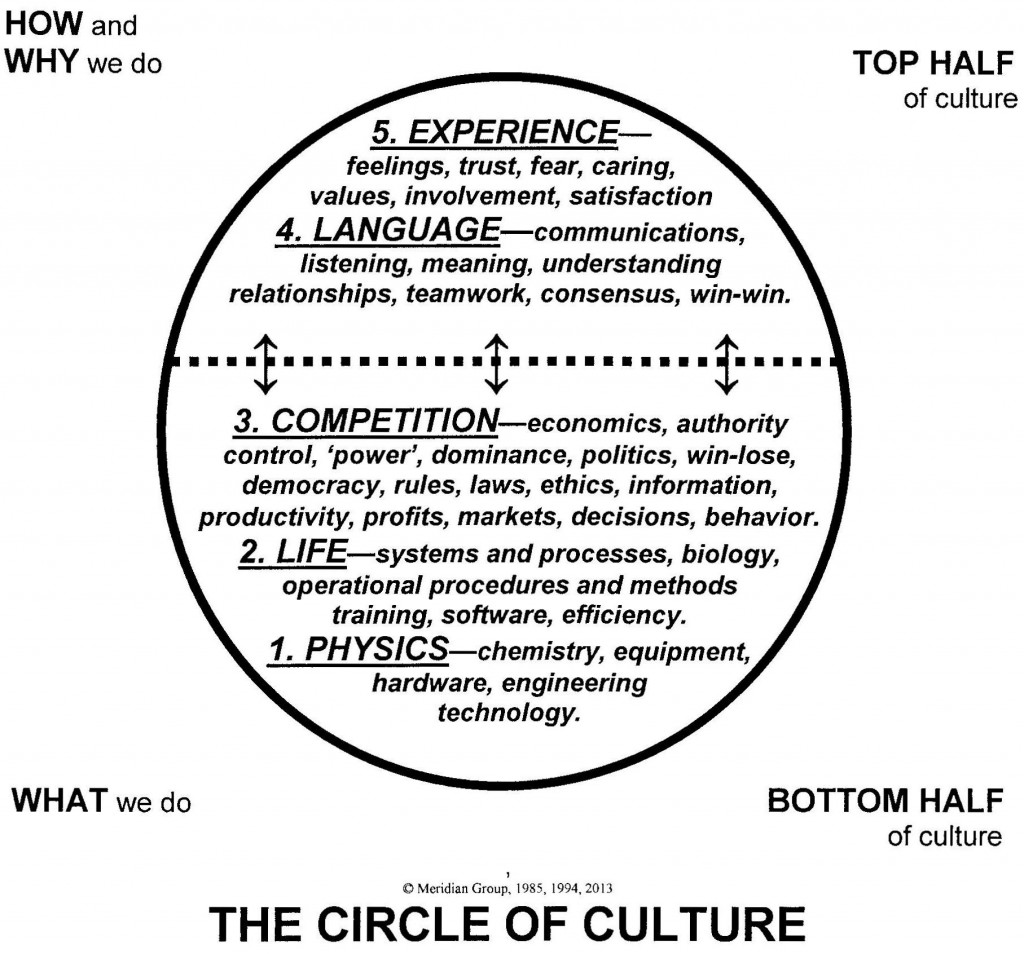You don’t need to know the structure of your brain or personality to change your attitude and behavior. Similarly, you don’t need to know the structure of your company culture in order to change it. However for those managers who’d like to know the basic structure of culture, here are the five distinct parts or levels. In a well-developed work culture, these parts are balanced. The first three you can analyze, the last two you can’t. See also Balance The Two Halves of Culture.
1. Physical Objects — equipment
 This is the first level of any culture. It includes tools and objects people use to build and make, the clothes they wear, the structures they live and work in, the products they trade or sell, and the art they create and cherish. This is the level of physics and chemistry, equipment, hardware, engineering, and technology.
This is the first level of any culture. It includes tools and objects people use to build and make, the clothes they wear, the structures they live and work in, the products they trade or sell, and the art they create and cherish. This is the level of physics and chemistry, equipment, hardware, engineering, and technology.
In some organizations, this level is very important — such as in a chemical plant. In other organizations, this may be quite insignificant. This is a level where the clearest analysis occurs, where you find the facts of science, and where conversation is the safest.
Equipment is not usually a dominant issue, but because it is comfortable and safe to talk about, it may be a frequent subject for discussions.
Academically this level includes physics, chemistry, and engineering.
2. Systems — coordinating equipment
 In organizations, this level includes operating systems, processes, procedures, and methods. It is where you find the software to control hardware, and where most training dollars are spent. The prototype system is a living organism, with complex feedback mechanisms, and that unique quality of living systems, homeostasis — the ability to maintain a stable internal state. This level holds the key to efficiency.
In organizations, this level includes operating systems, processes, procedures, and methods. It is where you find the software to control hardware, and where most training dollars are spent. The prototype system is a living organism, with complex feedback mechanisms, and that unique quality of living systems, homeostasis — the ability to maintain a stable internal state. This level holds the key to efficiency.
In most companies, there is plenty of room for process and systems improvements. Because the details and problems of systems are best known by those closest to them, this level is a golden opportunity for involvement. When you’re beginning on the company culture development process, this is the most obvious place to start — involving employees in improving the systems they work with.
Academically this level includes the life sciences, process engineering, and software development.
3. Authority Structure — connecting people to systems
 In organizations, this level includes authority, organizational structures, markets, information, productivity, and profits. People have refined some aspects of this level into economics, politics, laws, democracy, and ethics. Included here are competitive forms of decision-making such as win-lose, or combat. The key aspect of this level is power and control. In its crudest form, it involves dominance and submission.
In organizations, this level includes authority, organizational structures, markets, information, productivity, and profits. People have refined some aspects of this level into economics, politics, laws, democracy, and ethics. Included here are competitive forms of decision-making such as win-lose, or combat. The key aspect of this level is power and control. In its crudest form, it involves dominance and submission.
Control, power, and competition are major features of work cultures. They are also some of the most emotionally difficult to discuss. People may react defensively if this topic is put on the table for discussion. It is often more useful to work indirectly on power and control issues by starting with level 2, System issues. These invariably have level 3 components. As you work cooperatively on System issues, you’ll find that the problems around power and control will gradually diminish.
Academically this level includes economics, sociology, anthropology, philosophy, and much of business.
These first three levels contain everything that is not distinctively human. For example, power and control, the dominant features of most human cultures, are also present in most animal species. Also, all living systems, and many non-living systems, have processes. At the lowest level, everything contains matter and energy — physics and chemistry.
Now let’s look at the two distinctively human levels.
4. Communications — connecting people to people
 This is the first level that is distinctively human. While most animals communicate, only humans have the capacity for highly complex language and written communications. Communications contain listening, understanding, dialogue, relationships, and teamwork. It also includes empathetic forms of decision-making, such as consensus, and win-win.
This is the first level that is distinctively human. While most animals communicate, only humans have the capacity for highly complex language and written communications. Communications contain listening, understanding, dialogue, relationships, and teamwork. It also includes empathetic forms of decision-making, such as consensus, and win-win.
This is the level where managers have the most potential leverage. Building relationships and communications is the key to employee morale and motivation, to an engaged and productive workplace.
Academically this level includes the fields of psychology and psychiatry.
5. Experience — engagement, motivation, and trust
 Our self-aware experience as humans includes desirable and valued qualities and feelings such as trust, caring, safety, satisfaction, pride, commitment, and engagement. It also includes our spiritual or sacred side.
Our self-aware experience as humans includes desirable and valued qualities and feelings such as trust, caring, safety, satisfaction, pride, commitment, and engagement. It also includes our spiritual or sacred side.
Managers cannot affect another person’s experience directly, but they can affect it profoundly by their actions at the first four levels.
This is not an academic level as it lies beyond language and analysis.
A note on the word “levels”.
These five levels of culture are also the five major levels or steps of evolution on our planet. A curious aspect of these major evolutionary jumps is that the next level up is not visible from the previous level. Each major level steps into something unknown, something inconceivable at the previous state. For example, life is unimaginable from the rules of physics and chemistry. Power and authority are inconceivable from the rules of biological systems. Similarly, the complexities of language, imagination, and cooperation are unimaginable from the rules of the raw brutality of power. Finally, Homo Sapiens’ recent leap into self-consciousness — our self-awareness of our consciousness — is truly unimaginable from the rules of any of the previous levels.
Because each level is unimaginable from the rules of the previous level, this means you cannot see or understand the rules of the next level up from the rules of the previous level. For example, from the rules of competition, power, and authority you cannot see the rules of cooperation and consensus. To say that another way, people who imagine the world as only win-lose (if you get it I don’t) have trouble conceiving of a world as win-win (we both get more).
Sometimes managers resist cultural change because they can’t see past the first three (maybe four) levels. But usually, when they experience the power that comes from working at the human levels 4 and 5, they wish they had done this years ago, and swear they will never regress. But just like the path of evolution, you can’t see that until you’ve gone there. This is one reason a leader who decides to improve the culture must walk alone ahead, leading his or her team until the whole team experiences the new way of doing things. Their amazement and delight at the power and satisfaction from managing levels 4 and 5 was inconceivable from all they knew when working only at levels 1 – 3.
© Barry Phegan, Ph.D.
